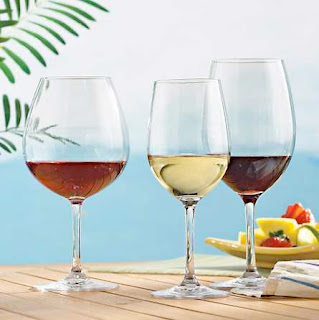Thursday, April 7, 2011
Animals in Odd Places...
Monday, April 4, 2011
How to Choose Stemware...
"Choosing wine glasses, also known as stemware, to reflect both the best of the wine and your own personal taste is both fun and easy with a little knowledge. The shape, size and color of a wine glass can dramatically affect your perception of the wine that's contained in it.There is no “proper” way to serve wine. There are no “official” sizes, capacities, shapes or colors of wine glasses. Common sense and individual taste should be your guide.Wine’s appeal is not just its taste and smell, but also the visual aspect. The play of light on the wine, the “legs” and “tears’ on the inner wall when you swirl the wine and the way aromas are captured within the wine glass — and presented to your nose while drinking — are things to consider when choosing wine glasses.It stands to reason that a larger glass is required for wine at dinner than would be needed for a sip of sherry after.
Traditionally wine glasses with larger, broader bowls are used for bold red wines with bigger bouquets, and narrower wine glasses are used to concentrate the more delicate aromas of lighter white wines.Champagne is best served in a tall slender tulip glass. Visual enjoyment of the bubbles that differentiate a sparkling wine from a still wine is enhanced by the height. The once popular shorter version of the Champagne glass — whose design was reputed to be based on an particular aspect of Marie Antoinette's anatomy — is too likely to spill and doesn't present the rising bubbles to best advantage or prolong the chill like a tall wine glass will.If your budget, available cabinet space or desire for simplicity limit your wine glass and stemware collection to a single size, a number of producers have made all purpose designs. Most all-purpose wine glass designs are attractive and relatively inexpensive.You may want to pick a design similar to what the California Wine Institute developed as an all-purpose wine glass. It is five and one half inches tall with a one and three quarter inch stem. Its clear, tulip-shaped bowl has a capacity of eight ounces.There is also an International Standards Organization (ISO) wine glass, but — like many of the wine glasses you might collect as souvenirs when tasting at wineries — it may be a better size for tasting wine — a little small for drinking wine.Riedel Crystal has developed a special tasting glass. The glass is made to have a small amount of wine poured into it, and then to be tipped on its side and rolled across a flat surface to coat its inside surface with wine. Watch out for spills! An elegant dinner party, where a different wine accompanies each course, is enhanced with a table setting that includes a wine glass for each wine. The glasses should be arranged in the order they are to be used and right to left. Wine is traditionally poured from the right, while food is served from the left.The food being served will dictate the choice of wine, but you will most likely begin with tall-stemmed hock glasses for whites and progress to wine goblets for reds then use a smaller glass for aperitifs. A matching water glass is an elegant touch. Be sure not to fill a wine glass too full, one third to one half full at the most. You want to leave room to capture the bouquet in the upper bowl as it rises from the swirled wine, and to allow the glass to be tilted — at approximately a forty-five degree angle — to evaluate and enjoy the color of the wine.The wine glass stem gives you something to hold onto without warming the wine with your body heat. If the wine happens to be served too cold, cupping the bowl in your hand is an easy way to quickly warm it up."








